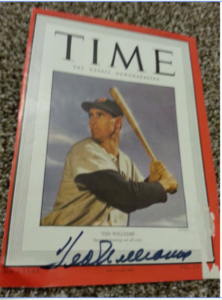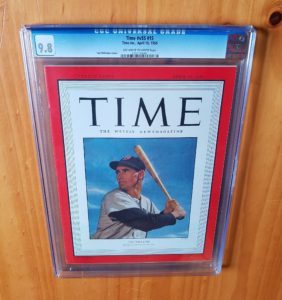Welcome to my 15th in a series of Sports Illustrated/TIME magazine blogs – Your collector’s guide to the latest hobby updates and insight into what’s trending now.
First a couple of housekeeping matters from previous blog #14:
Thanks to reader response, I’d like to qualify a statement from Blog #14 – “With any signature you buy or otherwise obtain, make sure you receive an accompanying certification (preferably from PSA , JSA, or CGC) of its authenticity. In general, the higher the profile of the athlete, the more important the certification.
And have a quality piece for your autograph.
Below is a $1000 signature on a 10 cent magazine (due to condition)

I wonder if the owner of the one above wishes he had that signature on the one below.

Enough said on the subject.
Thanks to my reader input on this one and feel free to send questions anytime.
Today’s blog, the first of two on the subject, is perhaps the most important and relevant blog I have written to date involving magazine collector opportunity.
In previous blogs, I have very briefly touched upon the existence of another high quality, popular and very collectable magazine which happens to be closely linked to Sports Illustrated. Perhaps some of you SI guys are like I used to be – steadfastly loyal to collecting only SI. Then I discovered another really cool and pertinent segment of the collectable magazine presence – TIME Magazine.
One of the first things you’ll notice upon a bit of research is that the two magazines, TIME and SI, have been forever joined together by publisher and chronology, a fact appealing to sports collectors in general. Time magazine’s first publish date, March 3rd 1923, marked the beginning of significant, responsible world news reporting by a single publication. Although primarily a world news magazine, TIME’s versatility stretched across the sports spectrum to all newsworthy sports, people, and events. As a testament to its trustworthy, respected global news coverage, TIME has remained in continuous publication since 1923. In 1954, Time Inc, recognizing the growing demand for a weekly sports magazine, expanded its publications to launch a new magazine – Sports Illustrated, Inc, and a star was born. As a result, TIME is forever recognized as the precursor of SI.
An interesting component within the timing of the SI launch is its relation to the first appearance of TOPPS baseball cards. Comparisons can be drawn between magazine publications and baseball card printing – TIME is to SI as Bowman is to TOPPS. Why do I make this point? While the actual grading of magazines may be more similar to that of comics than to that of cards (hence CGC being the dominant market share leader in the space), the other aspects of collecting SIs and the sports-oriented Time magazines that predate them are more analogous to cards. They are extremely condition sensitive, with very few older issues having survived the years in pristine condition. They are also scarce, cards having been tossed out as seemingly worthless in the 50s, 60s, and earlier, and magazine publication being limited, especially for newsstand copies estimated to comprise a mere 2% of total production annually. Finally, both are pieces of sports history and have an artistic component as well, thus appealing to avid sports fans and collectors of all things sports related.
However, unlike baseball cards of this era that have little continuity between printing years and manufacturers (significant breaks in printing between Tobacco and Topps), TIME magazine provides a nice, neat, uninterrupted transition right into its first publication of Sports Illustrated lending an easy and fun path to collect both, side by side. I have found that collectors are drawn to the unique opportunity of owning the best of both magazines. For example, the possibility of owning a first cover CGC 9.8 1950 TIME Ted Williams AND a first cover CGC 9.8 1955 SI Ted Williams is a collector’s dream. An additional benefit of this type of collecting is that graded magazines make for a highly attractive display as well as reminiscent conversation. Other similar vignettes available are Cassius Clay, Mantle, Mays, DiMaggio, Aaron, Musial, Jim Brown, Nicklaus, Palmer, Marichal, Lombardi, Bench, Rose and many more. For a complete list of TIME covers, just search a chronology of TIME magazine covers. Sports Illustrated has a published a picture review of every cover since 1954 for those interested in knowing what’s out there in SI.
If the esthetics, continuity, respectability and relationship to SI haven’t convinced you of TIME’s relevance, consider “age”. Some of these issues are approaching 100 years old and that’s old in magazine years. Although a very few early submissions have graded in the 9.0’s (one before 1936), any grade above CGC 6.0 is a rare find to date. More early TIME issues will surface but I’m betting the covers I have detailed above will grow in popularity and value exponentially compared to the rest of the market and as collectors scramble to own the highest grade of both mags. Once Mom and Pop realize what they have in their attic, more submissions will emerge which will reinforce my assertion that early TIME issues above the CGC grade of 6.0 will be hard to find.
To all avid SI collectors, keep TIME magazine on your radar screen as a great way to best bridge the time and space of sports magazine collecting.
Next blog: A review of TIME first appearance sports covers and why they are important. Also, I will rank the top 25 covers to target.
Great collecting to you and best fortunes with Sports Illustrated/TIME!
